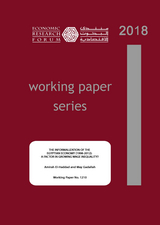
The Informalization of the Egyptian economy (1998-2012): a factor in growing wage inequality?
El-Haddad, Amirah / May GadallahExterne Publikationen (2018)
Kairo: Economic Research Forum (Working Paper Series 1210)
Variations in hourly wage rates explain most of gross earnings inequality among all workers in most countries (OECD 2011). Through running re-centered influence function regressions (aka Unconditional Quantile Regressions), we use Firpo et al. (2007) distributional approach to identify each control variable’s contribution on the traditional decomposition of wage changes into structure and composition effects. Contrary to the traditional Oaxaca-Blinder approach, we perform the decomposition at each wage quantile. We address this question for waged men using the Egyptian Labor Market Surveys for 1998, 2006 and 2012. A novel finding of this paper, which is in contrast to the previous evidence on inequality in Egypt (e.g. Paolo et al. 2014; Hlasny and Verme 2013), we find that wage changes between 1998 and 2012 mainly resulted in increased inequality. The richer percentiles have persistently enjoyed disproportionately larger positive changes in real hourly wages, especially between 2006 and 2012. Whilst increasing in all three wage gaps, inequality increased the most between the top and bottom deciles (the 90-10 gap). Informality of the private sector is the largest contributor to increased inequality. The sector does not adhere to a minimum wage. Being unregulated it has responded dramatically to the competitive pressures caused by the departing middle classes of the public sector by suppressing mid and low-end wages, thus resulting in the sharp wage gaps at the tails. Formality has a nuanced effect depending on sector. Wage setting dynamics of the public sector and the direction of labour movements since liberalization cause the sector to contribute much more to wage inequality than does its formal private counterpart. Hence, in a setting where the majority of the labour-force is outside the formal sector, yearly public sector wage raises and the minimum wage become instruments that increase inequality not ones that reduce it. Annual pay freezes are one option. Implementing self-targeted public works programs similar to those of the National Rural Employment Guarantee Act in India serve to increase the “effective informal minimum wage”, thus curbing wage inequality. This in turn will potentially enable wage progression thereby breaking the informality trap of low skill-low wage inertia.
